The Continental Grand Prix 5000 S TR (or GP5000 S TR, for short) replaces the German brand’s highly-rated tubeless road tyre, the GP5000 TL.
Launched on the back of Sonny Colbrelli’s victory at the 2021 Paris-Roubaix, Continental boldly claimed the GP5000 S TR is lighter, faster and more robust than before.
In a first for Continental road tyres, the GP5000 S TR is also compatible with hookless rims, to a maximum tyre pressure of 5.0bar / 73psi on all tyre sizes.
While my testing showed the GP5000 S TR does indeed shave some weight off versus an equivalent GP5000 TL (35.6 grams for a size 700 x 28c tyre), I wasn’t able to find the claimed 20 per cent reduction in rolling resistance.
Nevertheless, considering how fast the GP5000 TL was, and how well it balanced that speed with impressive levels of durability and grip, the GP5000 S TR undoubtedly remains one of the best road bike tyres for fast riding and racing.
That it has lost some weight, is now compatible with hookless rims and comes with a transparent/tan sidewall option, are reasons enough to celebrate.
Continental Grand Prix 5000 S TR installation
Out of the box and onto the scales, a 700 x 28c GP5000 S TR tyre weighs 280.6g. That’s just 0.6g above the claimed weight and 35.6g less than an equivalently sized GP5000 TL.
Compared to the competition, that’s some 10-20g heavier (per tyre) than an equivalently sized Schwalbe Pro One TLE, but 20g lighter than a 700 x 28c Pirelli P Zero Race TLR tyre, however, and just under 30g lighter than a Goodyear Eagle F1 Tubeless tyre.
Notably, the GP5000 S TR does size up slightly smaller than the GP5000 TL once installed.
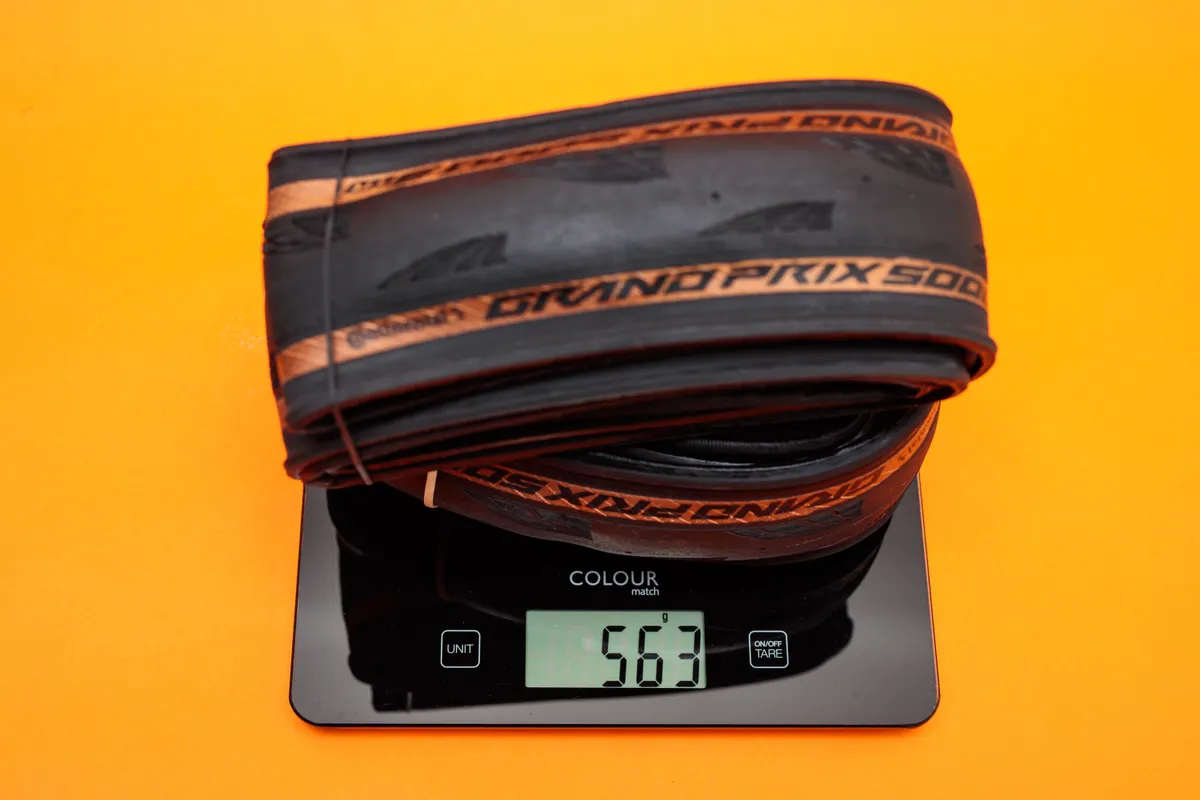
Inflated to 65psi / 4.48bar, the GP5000 S TR measures 28.4mm on the Hunt 54 Aerodynamicist wheelset (which has a 20mm internal rim width), whereas a GP5000 TL measures 28.6mm on the same wheels, at the same pressure.
Some of the 35.6g weight saving per tyre can perhaps be attributed to a small reduction in tyre size, then.
Hookless rims and internal rim width
If you’re mounting the GP5000 S TR on hookless rims, it’s worth noting Continental states the maximum inflation pressure on such rims is 73psi / 5.0bar, for all tyre sizes, as mentioned earlier.
Continental also gives maximum inflation pressures for hooked rims, as well as a maximum internal rim width measurement for each size in the range.
The 700 x 25c GP5000 S TR, for example, has a maximum internal rim width specification of 21c, meaning it isn’t compatible with ultra-wide rims such as those on the latest Zipp 303 S, 303 Firecrest and 353 NSW wheelsets (and any other rims with internal rims widths greater than 21c, of course).
On rims such as those, you’ll need to use a 700 x 28c GP5000 S TR, or larger.
That’s not an issue per se, given wheelsets that wide are typically optimised for 28c tyres or larger anyway, but it’s nevertheless something to be aware of.
| Continental GP5000S TR maximum inflation pressures | ||||||||
|---|---|---|---|---|---|---|---|---|
| Tyre Size | 700 x 25c | 700 x 28c | 700 x 30/32c | 650 x 30/32b | ||||
| Max inflation pressure on hooked rims | 7.5bar / 109psi | 6.5bar / 94psi | 5.0bar / 73psi | 5.0bar / 73psi | ||||
| Max inflation pressure on hookless rims | 5.0bar / 73psi | 5.0bar / 73psi | 5.0bar / 73psi | 5.0bar / 73psi | ||||
| Maximum internal rim width | 21c | 25c | 25c | 25c | ||||
Tubeless setup
When it launched, Continental also said the GP5000 S TR would be easier to install on tubeless-ready road bike wheels.
In my experience, the inelastic tubeless bead means it’s still a greater challenge to get both beads onto the rim than a GP5000 clincher tyre.
I was able to mount the GP5000 S TRs on Hunt 54 Aerodynamicist Carbon Disc wheels and DT Swiss ERC DICUT wheels without resorting to tools (something which wasn’t always possible with the GP5000 TL), though.
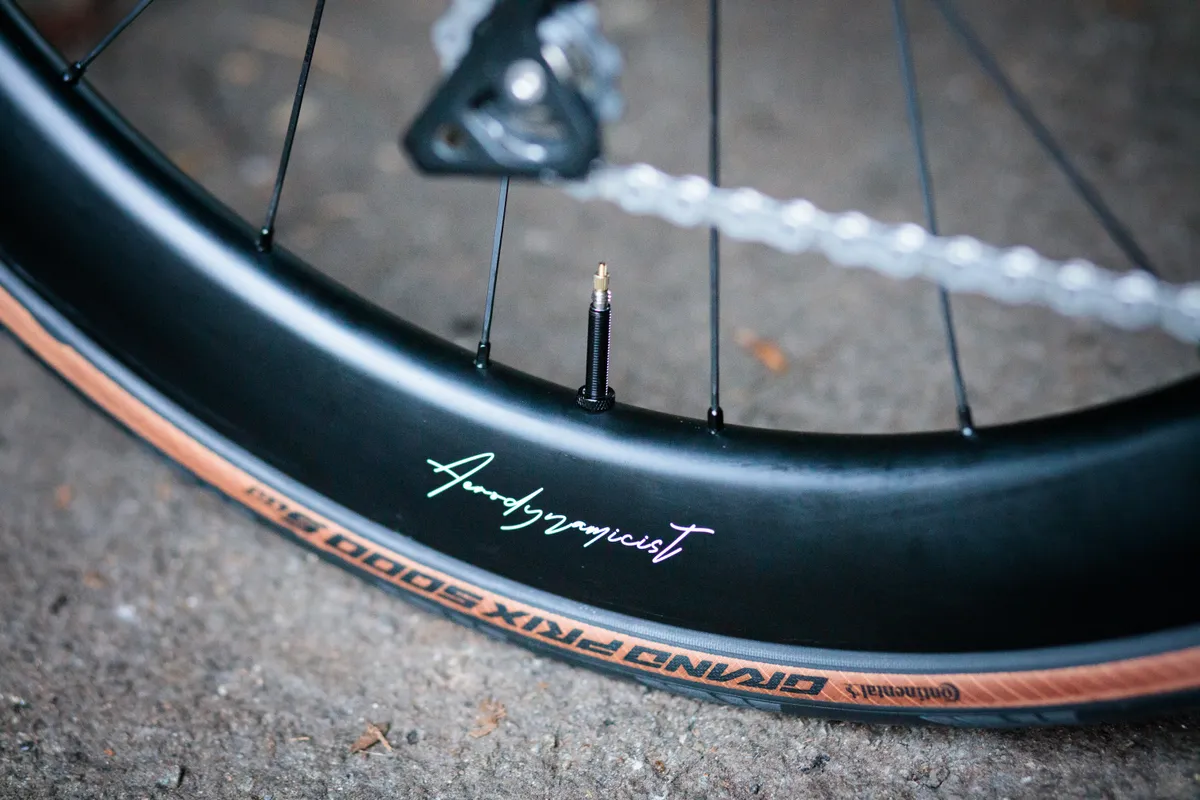
Installation was harder when using the GP5000 S TR with inner tubes, because the tube takes up a little room inside the well of the rim. This prevents both beads from falling into the deepest part of the channel and reduces the amount of slack available in the bead.
Given Continental indicated at launch there may not be an updated clincher-only version of this tyre in the future, those still committed to using tubes would therefore be wise to ensure their tyre-mounting technique is solid.
Once the tyre was mounted on a rim, seating the bead was a relatively painless affair, requiring only some vigorous pumping with a track pump and removing the valve core.
In all cases, getting the tyres off the rims required the use of tyre levers.
Continental Grand Prix 5000 S TR in use
On the bike, the GP5000 S TRs feel very similar to the outgoing GP5000 TL, which is no bad thing at all.
They’re noticeably fast and grippy, giving you heaps of confidence in corners and on descents, even on wet days.
The supple, two-ply casing (replacing a three-ply casing on the GP5000 TL) also offers plenty of comfort and vibration damping when used at appropriate inflation pressures.

Durability
Durability is hard to assess objectively, especially in the short-term – after all, it’s hard to account for occurrences such as small bits of glass strewn across the road – but, like the GP5000 TL, the GP5000 S TR retains a dedicated puncture protection belt beneath the tread.
The move from a three- to a two-ply construction, combined with the slightly lower weight, suggests durability may have decreased compared to the GP5000 TL (lighter tyres typically have less puncture protection because there’s simply less material for sharp objects to penetrate).
Given both tyres feel very similar in the hand, though, my instinct is that the GP5000 S TR will retain its predecessor's impressive durability and puncture resistance, especially when paired with one of the best tubeless sealants.
The GP5000 S TR still feels noticeably more robust than pure time trial tyres such as the Vittoria Corsa Speed TLR or Schwalbe Pro One TT (both of which forego a puncture protection belt under the tread).
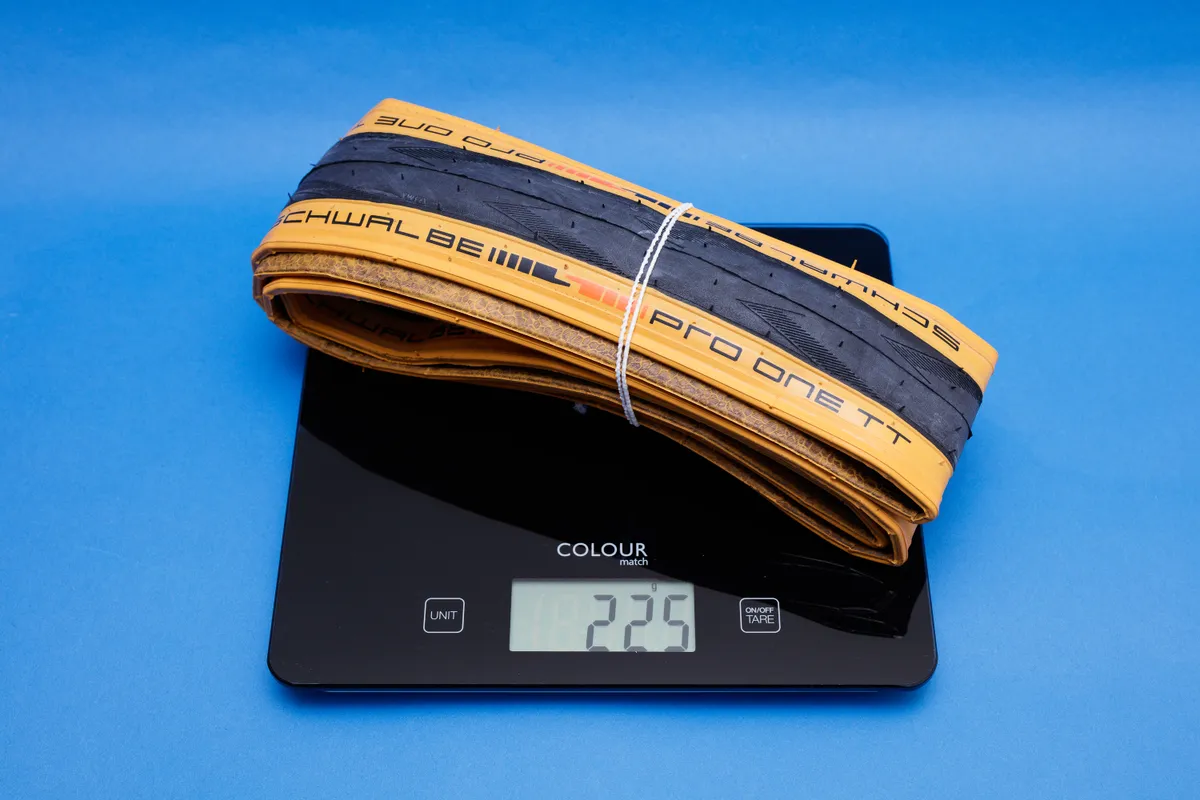
That it’s already taken a victory at a brutal race such as Paris-Roubaix also indicates it’s more than capable of handling the rough stuff.
This is still a tyre balanced for speed and grip rather than puncture protection, though. If you abuse it, its relatively thin casing and tread won’t offer the fit-and-forget experience of the best winter road bike tyres or a dedicated gravel bike tyre.
Rolling resistance testing
When the GP5000 S TR launched, Continental claimed it was “20 per cent faster” than the GP5000 TL.
Indoors on the rollers, however, my testing showed a small but consistent rolling resistance advantage to a set of lightly used GP5000 TL tyres.
Both those and the GP5000 S TRs were installed on the previously mentioned Hunt 54 Aerodynamicist Carbon Disc wheelset, using Vittoria latex inner tubes (for ease of setup and swapping between tyres), and were inflated to 90psi / 6.2bar.
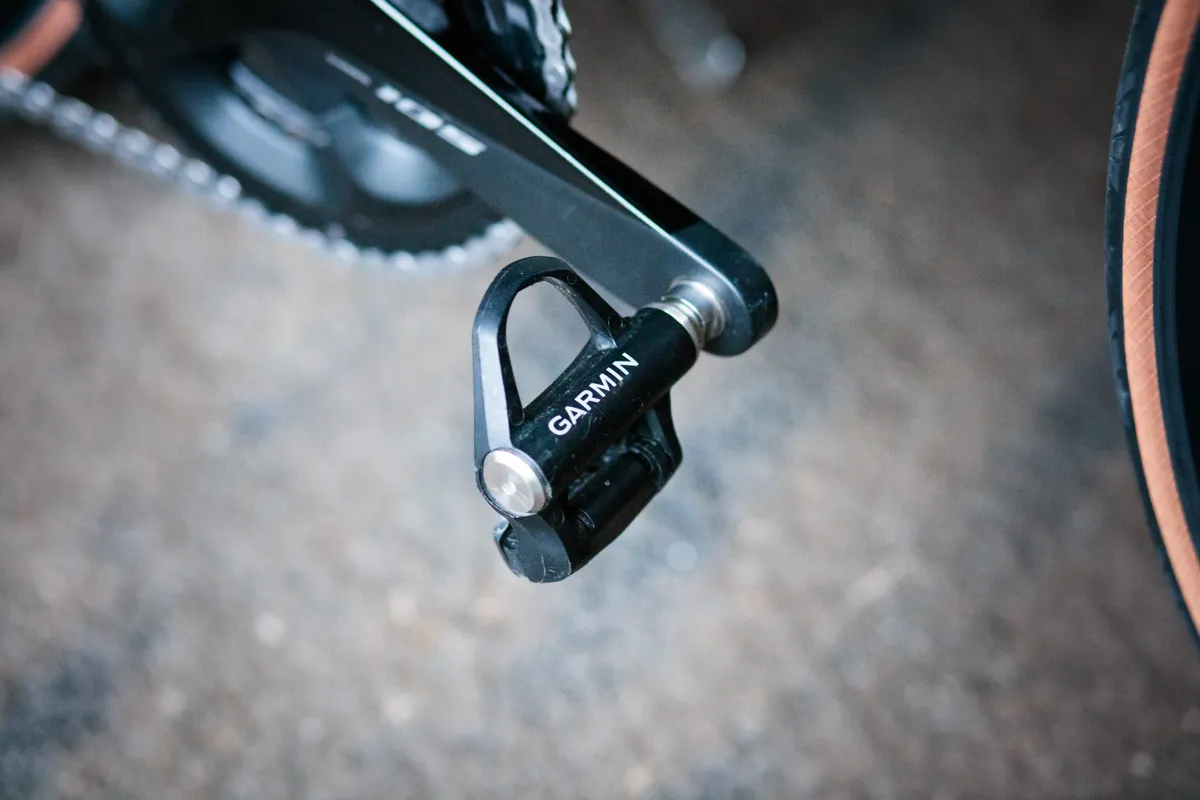
I then warmed up the tyres for five minutes, before completing a second five-minute interval at 45kph, noting the power required to maintain that speed using a set of Garmin Vector 3 power meter pedals.
I repeated this procedure multiple times, across different days, and kept everything else consistent to ensure the results were as accurate as possible.
| GP5000S TR / GP5000 TL roller testing | Run 01 | Run 02 | Run 03 | Run 04 | Run 05 | Run 06 | Run 07 | Run 08 | Run 09 | Run 10 |
|---|---|---|---|---|---|---|---|---|---|---|
| Date | 13/12/2021 | 13/12/2021 | 13/12/2021 | 13/12/2021 | 13/12/2021 | 13/12/2021 | 15/12/0201 | 15/12/0201 | 15/12/0201 | 15/12/0201 |
| Tyre model | GP5000S TR | GP5000S TR | GP5000S TR | GP5000 TL | GP5000 TL | GP5000 TL | GP5000 TL | GP5000 TL | GP5000S TR | GP5000S TR |
| Nominal tyre size | 700 x 28c | 700 x 28c | 700 x 28c | 700 x 28c | 700 x 28c | 700 x 28c | 700 x 28c | 700 x 28c | 700 x 28c | 700 x 28c |
| Measured tyre size (inflated width, mm) | 28.7 | 28.7 | 28.7 | 29.1 | 29.1 | 29.1 | 28.7 | 28.7 | 29.1mm | 29.1mm |
| Target speed (kph) | 45 | 45 | 45 | 45 | 45 | 45 | 45 | 45 | 45kph | 45kph |
| Warm up time | 00:05:00 | 00:05:00 | 00:05:00 | 00:05:00 | 00:05:00 | 00:05:00 | 00:05:00 | 00:05:00 | 00:05:00 | 00:05:00 |
| Tyre pressure (psi/bar) | 90 / 6.2 | 90 / 6.2 | 90 / 6.2 | 90 / 6.2 | 90 / 6.2 | 90 / 6.2 | 90 / 6.2 | 90 / 6.2 | 90 / 6.2 | 90 / 6.2 |
| Ambient temperature (celcius) | 20 | 21 | 21 | 20 | 21 | 21 | 20 | 21 | 21 | 21 |
| Rider weight (in all kit) | 65.6 | 65.6 | 65.6 | 65.6 | 65.6 | 65.6 | 65 | 65 | 65 | 65 |
| Bike weight | 8.32 | 8.32 | 8.32 | 8.39 | 8.39 | 8.39 | 8.39 | 8.39 | 8.32 | 8.32 |
| Lap time | 00:05:00 | 00:05:00 | 00:05:00 | 00:05:00 | 00:05:00 | 00:05:00 | 00:05:00 | 00:05:00 | 00:05:00 | 00:05:00 |
| Lap avg power (watts) | 144 | 140 | 140 | 132 | 133 | 131 | 133 | 133 | 140 | 139 |
| Lap distance (km) | 3.76 | 3.77 | 3.77 | 3.77 | 3.76 | 3.76 | 3.77 | 3.77 | 3.76 | 3.77 |
| Lap avg speed (kph) | 45.2 | 45.2 | 45.3 | 45.2 | 45.2 | 45.1 | 45.2 | 45.2 | 45.1 | 45.2 |
| Lap average cadence (rpm) | 82 | 82 | 82 | 82 | 82 | 82 | 82 | 82 | 82 | 83 |
| Results | ||||||||||
| Tyre model | GP5000S TR | GP5000 TL | Difference | |||||||
| Avg power on rollers (watts) | 139.75* | 132.4 | -7.35 | 5.26% | ||||||
(*Roller testing run 01 excluded from GP5000 S TR results – the unexplained increase of 4 watts seems anomalous in the context of all other runs.)
As you can see in the above table, the GP5000 TLs required just over 5 per cent less power on average (just over 7 watts) to ride on the rollers at 45kph.
It’s worth noting, however, the marginally larger size of the GP5000 TL (1.38 per cent at 90psi / 6.2bar) means the casing tension at equal tyre pressures would have been correspondingly higher compared to the GP5000 S TR.
This may have conferred a small advantage to the GP5000 TL in this test on perfectly smooth rollers, via a reduction in energy lost to casing deformation.
To validate these results, it was therefore important to perform real-world testing as well.
Real-world testing
For this, I performed multiple test runs up a 2km climb with an average gradient of 5.7 per cent (a section of Burrington Combe, for those interested), at a target average power of 250 watts, and recorded the time taken to complete the 2km.
A set of tyres with lower rolling resistance should, all else being equal, record a faster climb time for the same power output.
I rode seated for the entire climb, with my hands on the brake hoods and held as consistent a body position as possible throughout each run.
Tyre pressure in both sets of tyres was a more real-world-appropriate 65psi/4.48bar, which the Silca Professional Pressure Calculator suggested was optimum for my setup on the day.
| GP5000S TR / GP5000 TL climbing test | Run 01 | Run 02 | Run 03 | Run 04 | Run 05 | Run 06 |
|---|---|---|---|---|---|---|
| Date | 16/12/2021 | 16/12/2021 | 16/12/2021 | 16/12/2021 | 16/12/2021 | 16/12/2021 |
| Tyre model | GP5000S TR | GP5000S TR | GP5000S TR | GP5000 TL | GP5000 TL | GP5000 TL |
| Nominal tyre size | 700 x 28c | 700 x 28c | 700 x 28c | 700 x 28c | 700 x 28c | 700 x 28c |
| Measured tyre size (inflated width, mm) | 28.4 | 28.4 | 28.4 | 28.6 | 28.6 | 28.6 |
| Target average power | 250 | 250 | 250 | 250 | 250 | 250 |
| Tyre pressure (psi/bar) | 65 / 4.8 | 65 / 4.8 | 65 / 4.8 | 65 / 4.8 | 65 / 4.8 | 65 / 4.8 |
| Ambient temperature (celcius) | 12 | 11 | 11 | 11 | 11 | 11 |
| Lap time | 00:06:38 | 00:06:42 | 00:06:38 | 00:06:41 | 00:06:41 | 00:06:40 |
| Lap avg power (watts) | 253 | 253 | 254 | 253 | 253 | 253 |
| Lap distance (km) | 2 | 2 | 2 | 2 | 2 | 2 |
| Lap avg speed (kph) | 18.1 | 17.9 | 18.1 | 18 | 18 | 18 |
| Lap average cadence (rpm) | 86 | 88 | 87 | 86 | 87 | 89 |
| Lap average grade (%) | 5.7 | 5.7 | 5.7 | 5.7 | 5.7 | 5.7 |
| Results | ||||||
| Tyre model | GP5000S TR | GP5000 TL | Difference | |||
| Avg climb time (mins:secs) | 00:06:39 | 00:06:40 | 00:00:01 | -0.30% |
These results from my climbing tests show there is essentially no significant difference in performance between the GP5000 TL and the GP5000 S TR in the real world.
Though my test runs with the GP5000 S TRs were on average one second faster than those with the GP5000 TL, that represents only a 0.3 per cent difference in total average climb time.
This falls well within the margin for error I would expect when performing tests such as this in the real world, making this essentially a draw between the two sets of tyres.
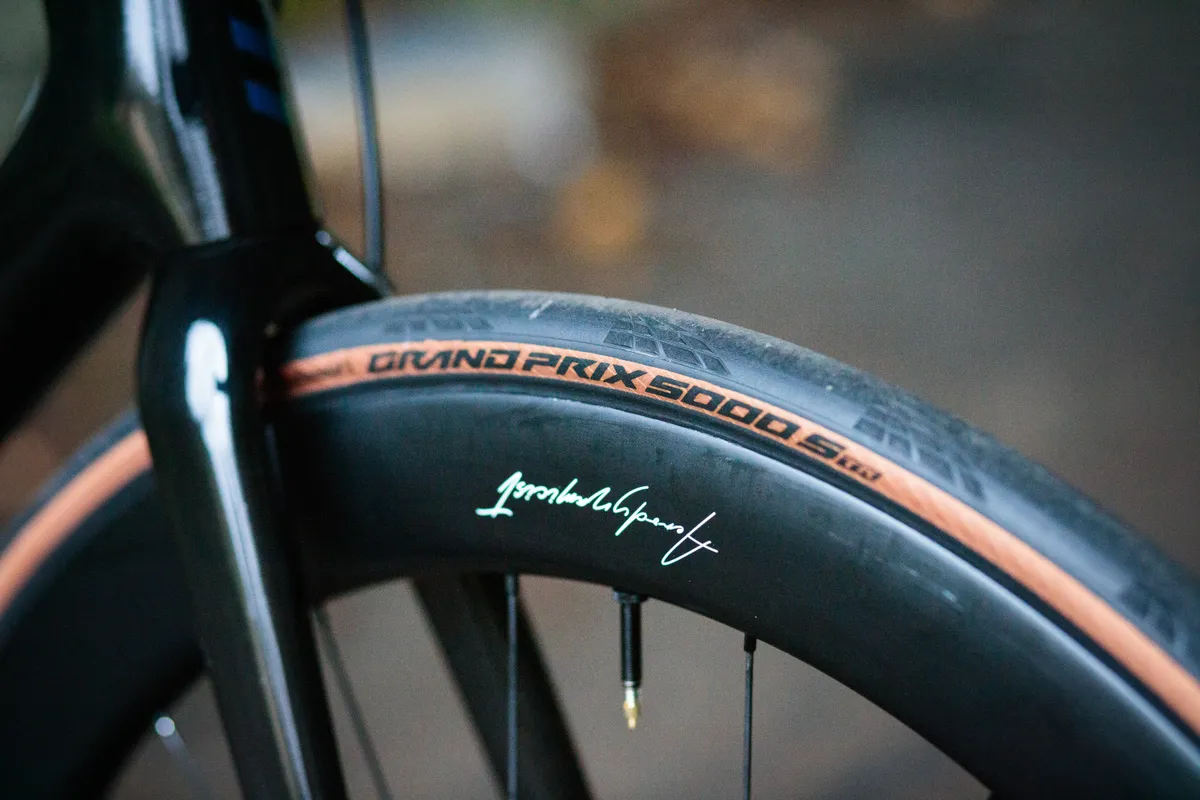
For example, considering the tests were performed on an open road with intermittent traffic, it’s possible a slightly different configuration passing vehicles on each run could account for this difference. This is because each passing vehicle would have briefly reduced my aerodynamic drag and increased my speed for the same effort.
Given my average speed for each run was around 18kph, any aerodynamic effects would have been small (hence why I chose a climb to perform these tests), but it can still make a difference.
On top of this, the Garmin Vector 3 power meter pedals have a stated accuracy range of +/-1 per cent.
Though my average power output on each run appeared to be very consistent, each figure is technically only accurate to within +/-1 per cent (+/- 2.53 watts in this instance), which could also account for the small difference in average climb time.
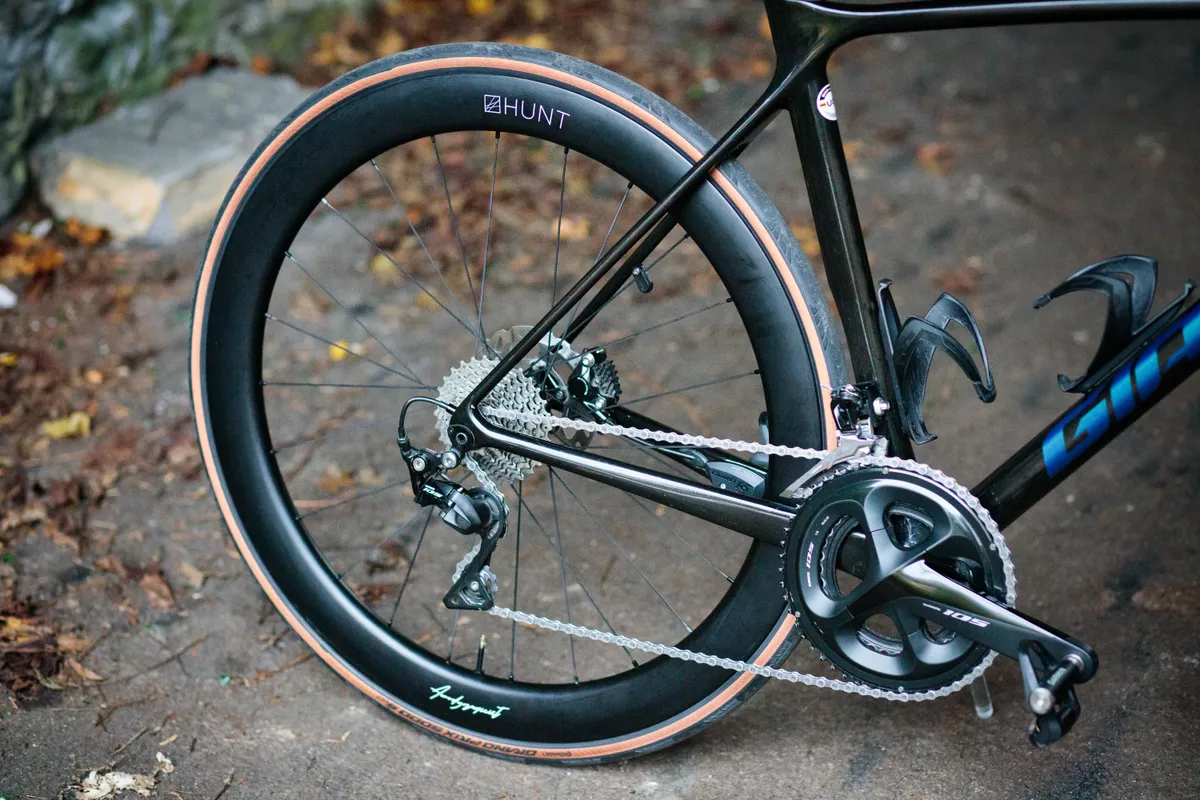
Continental Grand Prix 5000 S TR bottom line
Though the claimed decrease in rolling resistance versus the outgoing GP5000 TL appears to be too good to be true, the Continental GP5000 S TR nevertheless remains a benchmark tubeless road bike tyre.
It strikes an ideal balance of low rolling resistance, durability and puncture protection that makes it very hard to beat.
That it is now compatible with hookless rims and is available with a choice of black or transparent sidewalls, plugs what were arguably the only two chinks in its armour.
I’ll be sticking with my Vittoria Corsa Speed TLRs for time trials then, but for everything else on the road it’s hard to look past the GP5000 S TR
Performance tyres | How we tested
We put eight of the latest high-end tubeless road tyres to the test to find out which are worth your hard-earned cash.
To evaluate each tyre, we performed a combination of lab-based and real-world testing.
Our lab testing took place at the Silverstone Sports Engineering Hub, where we used its bicycle-specific rolling resistance rig to determine how efficient each tyre is. All else being equal, a tyre which produces less rolling resistance will enable you to ride faster for the same effort.
We then assessed how easy (or difficult) it was to mount a set of each tyre to rims and set them up tubeless.
Finally, we subjected the tyres to a series of test rides in the real world, to judge their subjective ride quality, grip levels and comfort.
Tyres on test
- Challenge Criterium RS review
- Continental GP5000 S TR review
- Goodyear Eagle F1 R review
- Michelin Power Cup TLR review
- Pirelli P Zero Race TLR review
- Schwalbe Pro One TLE review
- Specialized S-Works Turbo 2BR review
- Vittoria Corsa Pro TLR review
Product
| Brand | continental |
| Price | 79.90 EUR,69.95 GBP |
| Weight | 280.6000, GRAM (700x28c) - Per tyre |
Features
| br_TPI | 220 |
| br_bead | Tubeless-ready |
| br_punctureProtection | Vectran puncture belt under tread |
| br_tyreSizes | 700x25c, 700x28c, 700x30c, 700x32c, 650x30b, 650x32b |
SQUIRREL_13078502
